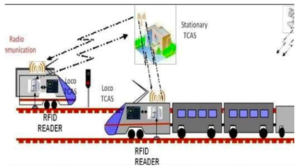Context:
The death of over 288 passengers in train accident in the Balasore district of Odisha has brought into sharp focus the safety mechanisms needed to prevent such tragedies.


Image Source: Hindustan Times
What is Kavach?- It is an indigenously developed Automatic Train Protection (ATP) system by the Research Design and Standards Organisation (RDSO) in collaboration with the Indian industry.
- Features:
- It is a state-of-the-art electronic system with Safety Integrity Level4 (SIL4) standards.
- It is one of the cheapest, SIL4 certified technologies where the probability of error is 1 in 10,000 years.
- Purpose: It is meant
- To provide protection by preventing trains to pass the signal at Red (which marks danger)
- To avoid collision between two locomotives
- Working:
- It activates the train’s braking system automatically if the driver fails to control the train as per speed restrictions.
- The system also relays SoS messages during emergency situations.
- It enables the centralised live monitoring of train movements through the Network Monitor System.
- Present deployment: The South Central Railway (SCR) Zone is a pioneer in the implementation of the KAVACH – (TACS). The Kavach system has been deployed over 1,465 kms in the SCR limits in 77 locomotives and 135 stations till March this year.
- The Traffic collision avoidance system (TCAS), with the help of equipment on board the locomotive and transmission towers at stations connected with Radio Frequency Identification (RFID) tags, helps in two-way communication between the station master and locopilot to convey any emergency message.
- The instrument panel inside the cabin helps the locopilot know about the signal in advance without visual sighting, and the permissible speeds to be maintained.
- If a red signal is jumped and two trains come face to face on the same line, the technology automatically takes over and applies sudden brakes.
- Implementation in a phased manner
- First priority lines: High Density Routes and the New Delhi-Mumbai and New Delhi-Howrah Sections, as they have higher chances of accidents because the trains run closer to each other.
- Second priority lines: Highly Used Networks
- Third priority lines: Other Passenger High Density Routes
- Final priority: To cover all other routes.
- Glitches about vulnerability of a vehicle crossing a closed level crossing, stray cattle or boulders on track, radio communication issues in tunnels, ghat sections, have been tackled.
Post Views: 254
